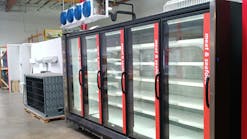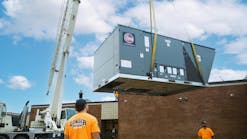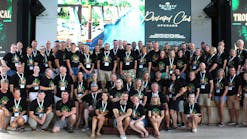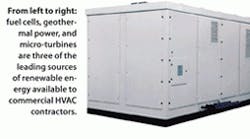The transition to an "energy era" is gaining momentum. The phrase, "going green" is familiar to every age group, profession, industry, and institution. However, going green can mean a lot of different things to different people, and there are a large number of mechanical, electrical, and plumbing (MEP) companies that are struggling with what it means to their businesses.
There are many green energy alternatives — renewable power, energy storage, smart grids, carbon capture, weatherization — and sub-systems that accompany them. Tied in with those methods are possible state and federal incentives, carbon credits, "green tags," "white tags," interconnection guidelines, feed-in tariffs, net metering, power purchase agreements (PPAs), and more. Therefore, it's not surprising that only a small number of MEP firms have climbed into the energy arena. Very few have formed partnerships with some of the world leading original equipment manufacturers (OEMs) to focus some of their business on energy-related MEP contracting.
But it's really not as complicated as you might think. For the next four years, and potentially longer, federal, state, and local governments will promote clean and renewable energy development power solutions. Contractors who have an interest in renewable energy must learn some of the best practices associated with making the transformation.
Learn the Technology
There are many energy products in the marketplace today, but none offer as natural an evolution for the typical MEP company as fuel cells, micro turbines, and geothermal systems. These systems are classified as electro-mechanical systems. They rely on many common features that MEP companies are used to working with. They include boilers, hot water heaters, chillers, and emergency generators. Additional supporting plant equipment includes pumps, heat exchangers, variable speed drives, cooling towers, and building controls.
It's therefore encouraging to know that your past experience has in some way prepared you for the jump to renewable energy systems. Here are some details related to fuel cells, micro-turbines, and geothermal systems:
Fuel cells. A typical fuel cell produces hot water, which can be in a range of temperatures depending on the technology and the manufacturer. One manufacturer can produce two completely separate streams of hot water for building heating and/or domestic hot water. The higher temperature water for heating the building can also be used to provide chilled water during summer, when it's piped into a single-effect hot water absorption chiller. The OEM supplies other mechanical components — such as a heat exchanger for heat rejection when the building load isn’t there, fresh make-up water connections, and if so equipped, a nitrogen purge connection.
Micro-turbines. Micro-turbines —when equipped with an on-board hot water heat exchanger for producing building heat and/or domestic hot water — can be used in exactly the same manner as a fuel cell. The difference between fuel cells and micro-turbines lies in their respective thermal and electrical output parameters, and the variations in size that the OEM typically manufactures. Fuel cell manufacturers tend to only offer a few different sizes, so the applications are limited. But the micro-turbine is offered in a multitude of size ranges, and can be coupled together to form larger systems. The other primary difference is on the financial side. Fuel cells are far more costly than micro-turbines, but they’re currently receiving far more substantial federal and state level incentives.
Geothermal. Geothermal energy gets far fewer headlines — and far less venture capital — than solar or wind power. It’s benefits, however, can't be understated. Geothermal actually supplies more megawatt-hours than either solar or wind power. Geothermal energy supplies a steady supply of energy that utilities can count on for baseload power, instead of intermittent sources such as solar or wind, which generate power when the sun shines or the wind blows — events that utilities can't control.
One manufacturer's geothermal power generator is actually an off-the-shelf centrifugal chiller that many MEP companies are familiar with already. The only difference is that they run it backwards: the compressor is now a turbine, and the motor is now a generator. From the MEP’s perspective, it's still a centrifugal chiller.
Despite your possible familiarity with micro-turbines, fuel cells, and geothermal systems, you may need some help with the electrical connections. This can be relatively easy, since OEMs and utility companies will provide very detailed guidance on the interconnection to the building. There are also specialized companies who only deal in the business of power generation interconnection. They can be of great help as you take your first steps.
Contact OEMs, Establish Relationships
Having worked for one of the largest OEMs of renewable and alternative power generation equipment, it was extremely frustrating for me to locate qualified contractors who understood the products, and with whom I could actually bid and partner with on those projects. This is still true today. Partnering and establishing relationships with the OEMs is a very important step to establishing your HVAC company as a credible expert in t he field.
Many OEMs offer training classes. If they don't, ask them to develop one. Remind them that it’s important to commercialize their products. Without good installation companies at their diposal, their products will never enter the market in larger volumes. This is the key to being able to install these systems anywhere in the world, without having to rely on incentives.
Strategic Partnerships
There are many talented mechanical companies out there, but I have yet to find one that can perform every task associated with these systems at an equal level of expertise in each area. Therefore, it's essential that you establish a team of professionals who can complement your business in specific areas, such as interconnection testing, regulatory issues, and codes and standards. Having that team in place will strengthen your ability to dependably deliver the highest quality product. You'll establish yourself as a market leader, strengthen your partners’ businesses, and help the energy industry become a credible and reliable source of clean power for years to come.
The installation contractor plays a huge role in the overall health of the industry. Without mass production of reliable, products and robust installations, they'll be nothing more than spotty "one-off" experiments. Gaining trust and mutual respect through quality workmanship and treating their company as your own will help form a bond that will last for years as your companies evolve and grow together.
Once you’ve established yourself as a leading installation company, there will be little competition. Many companies will not bother with competitive bidding, because there will be so few qualified companies that can compete against you. This could also lead to OEM distributorships and service business, depending on what your business model is and how you want to evolve in the industry.
Promote Your Company & Staff
To help promote your capabilities, attend trade shows, and find ways to showcase your products and your staff’s abilities and accomplishments. Seek endorsements from your partners that you can use for your website, at trade shows, newsletters,or other means.
When you don't reach out, you may just become a "local talent." Consequently, product manufacturers and engineering firms looking for experts in this field might overlook you, only because they never heard of you. Some are them are looking for full turnkey solutions. Others need professional input from an installer's perspective.
Most installation managers have great intentions and the customer's best interest at heart. But the fact is, most engineering companies have never installed these systems themselves, and don't seek feedback from the installation contractor. Having a company that can provide this service up front in the planning and design phase is critical to the success of the application and objectives.
Todd McLeod is president of Hiland Energy Services, LLC, South Windsor, CT. He has more than 25 years of experience in design, engineering, construction, and hands-on experience related to systems that use gas turbines, micro-turbine and absorption chilling CHP, fuel cells, and renewable technologies such as geothermal power plants. Prior to starting Hiland Energy Services, McLeod was vice president of energy services at Harrington Engineering, Rocky Hill, CT.
This article is based on "Best Practices for Entering the Renewable Energy Industry," which Todd McLeod presented during the Commercial HVACR Symposium as part of HVAC Comfortech 2009, in Nashville, TN. The next Commercial HVACR Symposium and HVAC Comfortech 2010 will be presented during HVACR WEEK, Sept. 22-24, in Baltimore, MD. Visit www.hvacrweek.com for additional information.









